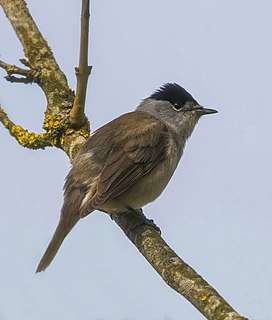
The Eurasian blackcap, usually known simply as the blackcap, is a common and widespread typical warbler. It has mainly olive-grey upperparts and pale grey underparts, and differences between the five subspecies are small. Both sexes have a neat coloured cap to the head, black in the male and reddish-brown in the female. The male's typical song is a rich musical warbling, often ending in a loud high-pitched crescendo, but a simpler song is given in some isolated areas, such as valleys in the Alps. The blackcap's closest relative is the garden warbler, which looks quite different but has a similar song.

Savi's warbler is a species of Old World warbler in the grass warbler genus Locustella. It breeds in Europe and the western Palearctic. It is migratory, wintering in northern and sub-Saharan Africa.

The Acrocephalus warblers are small, insectivorous passerine birds belonging to the genus Acrocephalus. Formerly in the paraphyletic Old World warbler assemblage, they are now separated as the namesake of the marsh and tree warbler family Acrocephalidae. They are sometimes called marsh warblers or reed warblers, but this invites confusion with marsh warbler and reed warbler proper, especially in North America, where it is common to use lower case for bird species.
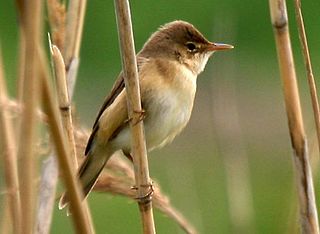
The Eurasian reed warbler, or just reed warbler, is an Old World warbler in the genus Acrocephalus. It breeds across Europe into the temperate western Palaearctic. It is migratory, wintering in sub-Saharan Africa.

The sedge warbler is an Old World warbler in the genus Acrocephalus. It is a medium-sized warbler with a brown, streaked back and wings and a distinct pale supercilium. Sedge warblers are migratory, crossing the Sahara to get from their European and Asian breeding grounds to spend winter in Africa. The male's song is composed of random chattering phrases and can include mimicry of other species. The sedge warbler is mostly insectivorous.
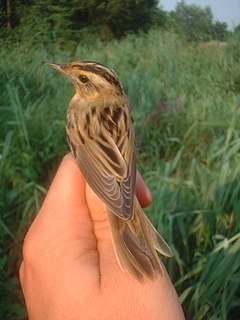
The aquatic warbler is an Old World warbler in the genus Acrocephalus. It breeds in temperate eastern Europe and western Asia, with an estimated population of 11,000-15,000 pairs. It is migratory, wintering in west Africa. After many years of uncertainty, the wintering grounds of much of the European population were finally discovered in Djoudj National Bird Sanctuary, Senegal, with between 5,000 and 10,000 birds present at this single site. Its south-westerly migration route means that it is regular on passage as far west as Great Britain and Ireland.
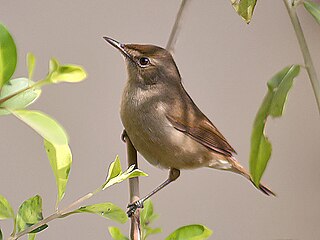
Blyth's reed warbler is an Old World warbler in the genus Acrocephalus. It breeds in the Palearctic and easternmost Europe. It is migratory, wintering in Bangladesh, India and Sri Lanka. It is one of the most common winter warblers in those countries. It is a rare vagrant to western Europe.

The great reed warbler is a Eurasian passerine in the genus Acrocephalus.
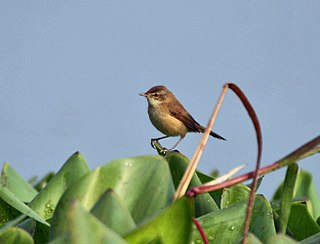
The paddyfield warbler is a species of marsh warbler. It was formerly included in the "Old World warbler" assemblage. The Manchurian reed warbler was included in A. agricola as a subspecies.

The moustached warbler is an Old World warbler in the genus Acrocephalus. It breeds in southern Europe and southern temperate Asia with a few breeding in north-west Africa. It is partially migratory. South-west European birds are resident, south-east European birds winter in the Mediterranean breeding range, and the Asiatic race migrates to Arabia, India and Pakistan.

The sedge wren is a small and secretive passerine bird in the family Troglodytidae. It is widely distributed in North America. It is often found in wet grasslands and meadows where it nests in the tall grasses and sedges and feeds on insects. The sedge wren was formerly considered as conspecific with the non-migratory grass wren of central and South America.

The clamorous reed warbler is an Old World warbler in the genus Acrocephalus. It breeds from Egypt eastwards through Pakistan, Afghanistan and northernmost India to south China and southeast Asia. A. s. meridionalis is an endemic race in Sri Lanka.

The Australian reed warbler is an Old World warbler in the genus Acrocephalus and is the only Acrocephalus species native to Australia. It has also been observed in Papua New Guinea and nearby islands. The name Acrocephalus refers to the peaked crown found on reed warblers in this genus and can be translated to mean "topmost head" in Greek. The species name australis is translated to mean "southern" in Latin, and refers to the species range, Australia. In its western range the Australian reed warbler is also known as "Koordjikotji" in the local Aboriginal language of Perth and its surrounds.

The peat therapy resortMoorbad Gmös in the vicinity of the town of Laakirchen is one of the few bogs in the Alpine foothills of Upper Austria. The bog dates back to the Mindel glaciation and was created by a "dead-ice hole". In 1987 the local authorities of Upper Austria declared the area of 3.4 ha of the Gmöser Moor a natural preserve. A path around the area has since then given the visitor the opportunity of observing rare flora and fauna. In 2002 the spa was chosen as background scenery for the TV-production Schlosshotel Orth.

The Basra reed warbler is a "warbler" of the genus Acrocephalus. It is an endemic breeder in Southwestern Iran, East and southern Iraq, Kuwait, and Israel in extensive beds of papyrus and reeds. It is easily mistaken for the great reed warbler but is a bit smaller, has whiter underparts and has a narrower, longer and more pointed bill. It winters in East Africa. It is a very rare vagrant in Europe. The call is a gruff 'chaar', deeper than a reed warbler's.

The African reed warbler or African marsh warbler is an Old World warbler in the genus Acrocephalus. It breeds in much of Africa south of the Sahara. It is migratory within the continent, with southern breeding population moving to the tropics in the southern hemisphere's winter.

The black-browed reed warbler is a marsh-warbler in the family Acrocephalidae. It was formerly included in the "Old World warbler" assemblage. The species was first described by Robert Swinhoe in 1860.

The speckled reed warbler or streaked reed warbler is an Old World warbler in the family Acrocephalidae. The species was first described by Robert Swinhoe in 1863.

The Oriental reed warbler is a passerine bird of eastern Asia belonging to the reed warbler genus Acrocephalus. It was formerly classified as a subspecies of the great reed warbler of the western Palearctic.
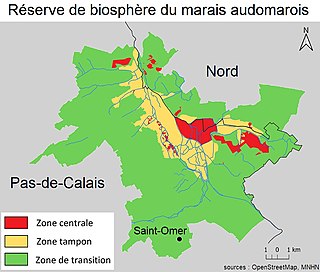
The Marais Audomarois is a biosphere reserve in the north of France. The renowned Ramsar site of wetland covers some 22 300 hectares, including the city Saint-Omer.


























